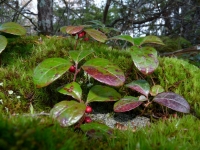Description
Wintergreen, Gaultheria procumbans, is one of two species of Gaultheria native to Wisconsin. A rhizmatous, spreading shrub, G. procumbans seldom exceeds 6 inches in height and its roots rarely penetrate more than 2 inches into the soil. Wintergreen forms a dense ground cover with 1 to 4 inch, glossy, round, evergreen leaves. Small, less than half inch, tubular white flowers are followed by a red berrylike capsule fruit. Gaultheria is in the family Ericaceae which includes other familiar plants such as blueberries and rhododendrons.
Range
Wintergreen is a species of eastern north America extending from Canada to Florida. The western edge of it's range forms a north to south line from Minnesota through Wisconsin down to Mississippi.
Habitat/Cultivation
Acidic soil is the most important requirement for wintergreen followed by a penchant for partial shade. As long as the soil is acidic and contains a good amount of humus (decomposed leaf litter) it doesn't really matter if it has a clay, loam, or sand base. Milwaukee residents who whish to grow this endearing little plant will want to plant it near, but not directly underneath (unless there is a lot of bright light), conifers or will need to amend the soil with acidic compost. One very convenient soil amendment for acid loving plants is peat moss but there are valid questions about the environmental impact of peat moss harvesting from bogs. Well-composted wood chips, pine needles or oak leaves may work equally well.
Wildlife value
Like other other evergreen plants in temperate and polar regions, wintergreen keeps its leaves in order to continue photosynthesizing (making food) through the winter. Because its berries and leaves persist throughout the winter wintergreen provides food for various birds such as grouse and wild turkey as well as mammals like white tailed deer, foxes, bears, and chipmunks. A handful of insects also feed on the plant although most are repelled by the strong aromatic chemical in its leaves, methyl salicylate. Remarkably, the release of methyl salicylate when the leaves are damaged by herbivory attracts preditory insects which then consume the herbivorous insects.
Cultural Value
Wintergreen produces methyl salicylate as an anti-herbivory defense but the chemical is harvested for a huge number of uses. Oil of wintergreen is processed from the leaves and used in low concentrations as a flavoring in a variety of foods such as gum and candies as well as for its fragrance. Methyl salicilate is also used in creams and ointments to provide relief for muscle and joint pain. Methyl salicylate is metabolized by the body into salicylic acid which is a NSAID (Nonsteroidal anti-inflammatory drug). It is toxic except in very low concentrations so wintergreen and other sources of methyl salicylate should not be consumed in significant quantities.





